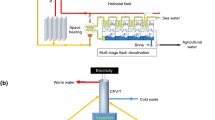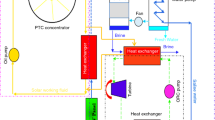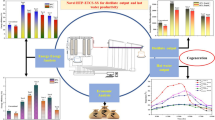Abstract
This article presents a thermodynamic analysis for a proposed hybrid system suitable for producing power or fresh water for small communities. The system includes a power generation loop and a desalination loop. These loops can work separately to produce power or combined to produce fresh water. The power loop comprises a solar pond, flashing chamber, vapour compressor VCI, steam superheater, steam turbine and a steam condenser. The desalination loop includes a vapour compressor VCII, vertical tube evaporator unit, multi stag flash feed heater and a heat rejection steam condenser. Hot water from the pond (97°C) is introduced into the flashing chamber and the generated steam is compressed to 125 kPa. Then the steam is superheated (using fuel) to a temperature of 315°C and is allowed to expand in a low pressure steam turbine exhausting into a condenser at 10 kPa. The turbine & VCI are mounted on the same shaft and the balance in the power generated can be used either as shaft power available or specifically for driving a desalination loop. This could be either a reverse osmosis RO or a vapour compression system. However, the analysis showed that the second one is more efficient than the RO. The VCII, driven by the turbine, is working across a 3-VTE multi effect unit associated with a 13-stage MSF feed heater coupled with an end condenser at 10kPa. Calculations showed that the power loop of a 100 m × 100 m solar pond assisted by 13 percent of its heat requirements, using fossil fuel, can generate 70 kW shaft power with a basic efficiency of 15%. When this loop is combined with a VC/VTE-MED unit a 200 t/day of fresh water can be produced at a PR of 9.4 and a thermal energy consumption (fuel) of 31 kJ/kg water produced which is less than any other system including the RO.
Zusammenfassung
Der Aufsatz bringt eine thermodynamische Analyse für ein vorgeschlagenes Hybridsystem, das geeignet ist, Energie oder Frischwasser für kleine Gemeinden zu produzieren. Das System beinhaltet einen Kreislauf zur Leistungserzeugung und einen zur Entsalzung. Die beiden Kreisläufe können getrennt arbeiten, um Energie zu erzeugen oder kombiniert, um Frischwasser zu produzieren. Der Energiekreislauf enthält einen Solarteil, eine Entspannungskammer, einen Dampfverdichter (VCI), einen Dampfüberhitzer, eine Dampfturbine und einen Kondensator. Der Entsalzungskreislauf beinhaltet einen Dampfkompressor (VCII), eine Vertikalrohr-Verdampfereinheit, einen vielstufigen Brüdenerhitzer und einen Kondensator mit Wärmerückgewinnung. Heißes Wasser aus einem Behälter (97°C) wird in die Entspannungskammer geleitet und der erzeugte Dampf wird auf 125 kPa verdichtet. Dann wird der Dampf auf eine Temperatur von 315°C mit fossilem Brennstoff überhitzt und anschließend in einer Niederdruckturbine entspannt, hinter der er in einen Kondensator bei einem Druck von 10kPa strömt. Die Turbine und der Dampfkompressor (VCI) sind auf derselben Welle montiert und der Leistungsüberschuß kann entweder als mechanische Arbeit oder speziell zum Antrieb des Entsalzungskreislaufs benutzt werden. Dieser Entsalzungskreislauf kann entweder nach der umgekehrten Osmose (RO) oder nach der Dampfkompression arbeiten. Eine Analyse zeigte, daß die zweite Methode wirkungsvoller ist als die erste. Der Dampfverdichter (VCII), der ebenfalls durch die Turbine angetrieben wird, arbeitet auf eine dreistufige „multi effecf“-Einheit, verbunden mit einem dreizehnstufigen MSF-Brüdenvorwärmer, der am Ende an den 10kPa-Kondensator angeschlossen ist. Berechnungen zeigten, daß der Energiekreislauf, der zu 87% aus einer 100×100 m Solarfläche und zu 13% aus fossiler Befeuerung gespeist wird, 70 kW Wellenleistung mit einem Wirkungsgrad von 15% erzeugen kann. Wenn dieser Kreislauf mit einer VC/VTE-MED-Einheit kombiniert wird, kann man 200 t/d Frischwasser produzieren bei einer „performance ratio“ von 9,4 und einem fossilen Energieverbrauch von 31 kJ/kg, der günstiger ist als bei jedem anderen System einschließlich der umgekehrten Osmose.
Similar content being viewed by others
Abbreviations
- C :
-
specific heat
- L :
-
latent heat of evaporation
- m :
-
mass flow rate
- M :
-
total mass flow rate
- PR :
-
performance ratio
- Δt :
-
inter-feed heater temp. difference
- ΔT :
-
inter-effect temperature difference
- y :
-
flashing fraction
- d :
-
distillate
- f :
-
feed
- v :
-
vapour
- s :
-
steam supply
References
Darwish, M.: Solar ponds, a seasonal solar energy storage system for process heating application. Solar Storage Workshop, Proc. 8, Jeddah, 21–24 March (1982)
Koai, K. et al.: Performance analysis of a solar powered/fuel assisted RanKine cycle with a novel 30 hp turbine. Sol. Energy 32 (1984) 753
Lior, N.: Solar energy and the steam Rankine cycle for driving and assisting heat pumps in heating and cooling modes. Energy Conversion 16 (1977) 111
Tabor, H.: Large area solar collector for power production. Sol. Energy 7 (1963) 189
Nielsen, C. et al.: Flow system for maintenance of salt concentration in solar ponds. Sol. Energy 19 (1977) 763
Winsberg, S.: Solar perspective solar pond innovator. Solar World 5 (1981) 4
Westgarth, R. et al.: Chamber geometry in multistage flash evaporators. ISW, PB 181 682 (1964)
Hanbury, W.: Multi-stage flash practice. A short course on Desalination Tech. Jeddah, 18–30 March (1980)
Senatore, S.: Vapour compression distillation. Proc. 7th Int. Symp. Fresh Water from the sea, Amsterdam (1980)
Hanbury, W.: Multi-stage flash distillation. A short course on Desalination Tech. Jeddah, 18–30 March (1980)
Barber, R.: Solar Rankine air-conditioning system. ASHRAE Trans. 2 (1979) 760
Lof, G.: Design and operating principles in solar distillation basins. Salin Water Conversion. Adv. Chem. Ser. 27 (1960) 156
Author information
Authors and Affiliations
Rights and permissions
About this article
Cite this article
Aly, S.E. Solar pond/fuel assisted water desalination plant. Wärme- und Stoffübertragung 20, 263–268 (1986). https://doi.org/10.1007/BF01303460
Received:
Issue Date:
DOI: https://doi.org/10.1007/BF01303460




